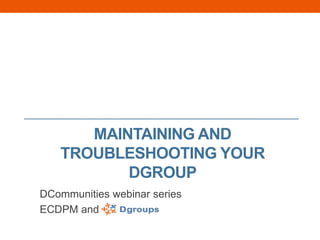Troubleshooting your Dgroup
- 1. MAINTAINING AND TROUBLESHOOTING YOUR DGROUP DCommunities webinar series ECDPM and
- 2. Meet the facilitation team Lucie Lamoureux KM4D Associates Pier Andrea Pirani Euforic Services ŌĆō Dgroups Coordination Support Ivan Kulis ECDPM
- 3. Why a DCommunities webinar series? ŌĆó Response to Dgroups partners request ŌĆó Engaging members requires care, skills and time ŌĆó Pilot - 3 free webinars to learn ŌĆó Dgroups platform ŌĆó Developing and supporting your Dgroup ŌĆó Troubleshooting your community
- 4. Webinar outline ŌĆō 90 minutes ŌĆó Agenda: ’ā╝ Webinar set-up ’ā╝ Introductions ŌĆō clock method ’ā╝ Case and discussion ŌĆō low participation ’ā╝ Facilitation tips and tricks ’ā╝ Case and discussion ŌĆō balance between formal and informal ’ā╝ Any other potential case(s)?
- 5. Webinar set-up ŌĆó Format: ’ā╝ Two cases from the group: introduction of community and challenge, then approx. 20 min discussion ŌĆó Interaction: ’ā╝During the discussion, please use the ŌĆ£Raise HandŌĆØ emoticon on the top left to contribute ’ā╝We will also use the ŌĆ£clock methodŌĆØ to ensure participation ŌĆó Technical problems: ’ā╝ Type in the Chat box and Pier will help you
- 6. Clock method introductions ŌĆóWill give you a time/number on the clock as you arrive ŌĆóUse it to go around ŌĆō interaction tool
- 7. Case no. 1: low/passive participation ŌĆó Alashiya and Claudia ŌĆó Internal Technical Network on Climate Climate (TN) at FAO ŌĆó Background of TN (2 mins) ŌĆó Specific challenge and what they are doing to meet it (3 mins) ŌĆó Discussion (20 ŌĆō 25 mins)
- 8. Troubleshooting facilitation tips ŌĆó Ask questions ŌĆó Provide resources and links ŌĆó Seek concrete group action opportunities ŌĆó Positive reinforcement ŌĆó Mix of formats (i.e. both online and off) ŌĆó Offline contacts (back channel) ŌĆó Inquire about silence ŌĆó Address emerging needs
- 9. Case no. 2: formal vs informal communities ŌĆó Yacine - Manager/facilitator ŌĆó Caribbean ICT stakeholders virtual community (CIVIC) ŌĆó Background of CoP (2 mins) ŌĆó Specific challenge and what they are doing to meet it (3 mins) ŌĆó Discussion (20 ŌĆō 25 mins)
- 10. Community growth questions ŌĆó Is there such a thing as critical mass? ŌĆó Is bigger better? ŌĆó Can we stay focused? ŌĆó How do we ensure that everyone is on board? ŌĆó Do we need to split up into sub-communities?
- 11. Case no.3: ? ŌĆó Any issues any of you would like to raise for discussion ŌĆó Any community tips you would like to share?
- 12. FurthermoreŌĆ” ŌĆó This webinar was developed using the following resources: ŌĆó https://www.diigo.com/user/pierandrea/e-discussion ŌĆó Nancy WhiteŌĆÖs Full Circle Associates tips: http://www.fullcirc.com/community/facilitips.htm ŌĆó Eldis resource on e-discussions: http://community.eldis.org/.5a91590f
Editor's Notes
- #3: My name is Lucie Lamoureux and IŌĆÖm very happy to be your webinar host today. Together with me in the facilitation team are Pier Andrea Pirani and Ivan Kulis. Pier will be our technical host for the session and Ivan will be managing the chat box.
- #4: Why are we doing this pilot webinar series? This is in response to Dgroups partners demand to support their admins and users to use the platform at his full potential. Setting up a community is easy but engaging members requires care, skills and time. Together with ECDPM, weŌĆÖve planned this pilot series of 3 webinars that to help users to understand the ins and outs of the Dgroups platform (webinar no.1 in March), learn the basics for online community building, from planning to design to facilitation (webinar no. 2 back in April), and finally this webinar on troubleshooting your community, which aims to be a more interactive and practical session.
- #5: So over the next 90 minutes, we will cover the following topics.
- #6: Before we jump into the content, this is how we have set-up this webinar. We will have two cases from this group, who will introduce their community and a specific challenge related to it. We will then discuss the issue and come up with suggestions and ideas for our peers. During the interaction portion, weŌĆÖll ask you to use the ŌĆ£Raise HandŌĆØ emoticon on the top left. We will also use the clock method technique, which I will explain shortly. If you have questions anytime during the webinar, please type them into the Chat box and Ivan will collect them. If ever you encounter technical issues, please type in the Chat box asking for help and Pier will take care of you. If you drop out, try coming back in by clicking the link to re-enter the room.
- #7: I have given you a number as you arrived in the webinar call. Click on the microphone icon to introduce yourself and where you are from. We will also use it a bit later as an interaction tool.
- #9: Here are some extra idea for getting more participation in your community.
- #11: YacineŌĆÖs case actually highlights an issue concerning community growth. His community has been around for 13 years; many of your communities are starting out and your issues are around getting it started and enhancing participation. But what happens once your community is more mature? Here are a few questions that are related to community growth. Keep in mind that the answers may vary according to the different types of communities.
- #13: These are the resources we used to develop the webinar and they are very useful ones to check out! The next webinar will be a more practical clinic based on your real-life community facilitation problems. So sign up for facilitation tips and tricks! Thanks to my colleagues Ivan and Pier and think you all!












